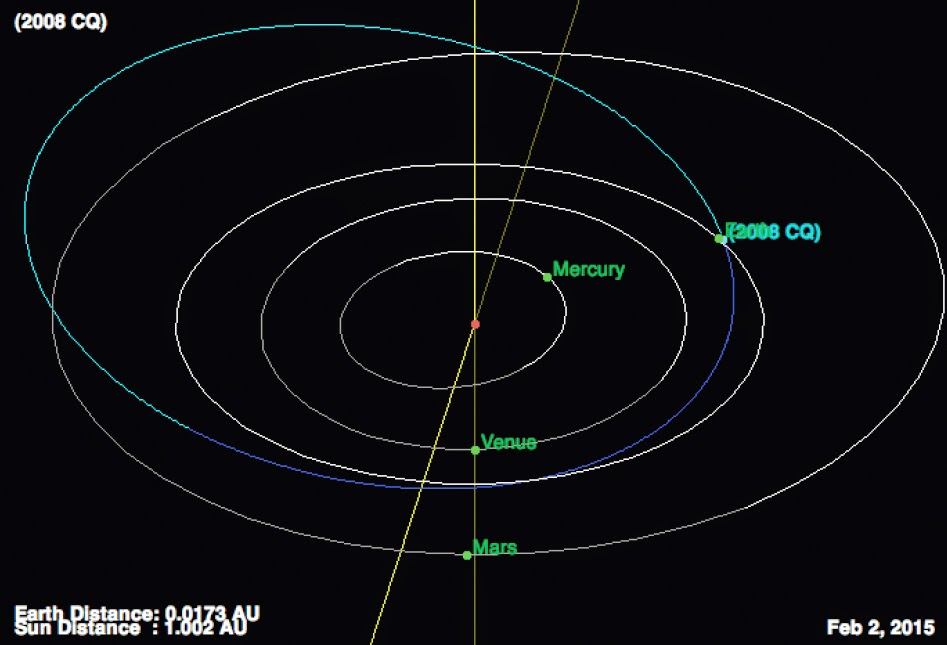Asteroid (357439) 2004 made a close approach to the Earth on Monday
26 January 2015, enabling scientists at NASA's Deep Space Network antenna at
Goldstone, California to collect radar images of the object. These revealed
that the 325 m asteroid has a small moon, which is approximately 70 m in
diameter. This is not the first asteroid to be found to possess such a moon; it
is thought that abut 16% of Near Earth Asteroids larger than 200 m have such a
companion body, and the figure may be similar or even higher for asteroids
further out in the Solar System (though this is harder to assess).
(357439) 2004 BL84 and its newly discovered moon.
NASA/Deep Space Network.
The close encounter also enabled scientists at NASA’s InfraredTelescope Facility on Mauna Kea, Hawaii, to study the spectroscopy of the
asteroid, with initial results suggesting it has a surface composition similar
to that of Vesta. (357439) 2004 BL84 is of particular interest as it is a
Potentially Hazardous Asteroid (an asteroid larger than 150 m in diameter that
is known to come within 0.05 AU of the Earth), and this was considered an
excellent opportunity for observation as it is the closest predicted flyby of
such a large object until 2027, when 1999 AN10, thought to be between 800 m and
1.8 km in diameter, will pass us at about 390 000 km (roughly the same distance
as the Moon), and encounter that should be visible through binoculars.
Asteroid (357439) 2004 BL84 passed by the Earth at a distance of 1
200 000 km (3.1 times the average distance between the Earth and the Moon, or 0.8
% of the average distance between the Earth and the Sun), at about 4.20 pm GMT
on Monday 26 January 2015. There was no danger of the asteroid hitting us,
though had it done so it would have presented significant minor threat. With an
estimated equivalent diameter of 325 m (i.e. it is estimated that a spherical
object with the same volume would be 325 m in diameter)(357439) 2004 BL84would
be expected to be capable of passing through the atmosphere reasonably intact,
impacting the ground in an explosion equivalent to about 1800 megatonnes of TNT
(roughly 106 000 times the energy of the Hiroshima bomb) and creating a crater
about 5 km in diameter. Such an event would cause devastation over a wide area,
and could cause climatic problems for decades.
(357439) 2004 BL84was discovered on 30 January 2004 by the Massachusetts Institute of Technology's Lincoln Near Earth Asteroid Research Laboratory
in Socorro, New Mexico. The designation 2004 BL84 implies that it
was the 2111th asteroid (asteroid L84) discovered in the second half of January
2004 (period 2004B).The longer designation, 357439 indicates that the asteroid
was the 357 439th asteroid ever discovered. Asteroids are not given this longer
designation immediately, to avoid duplicate or false sightings
(357439) 2004 BL84has a 672 day orbital period and an eccentric
orbit tilted at an angle of 23.7° to the plane of the Solar System, which takes
it from 0.89 AU from the Sun (i.e. 89% of the average distance at which the
Earth orbits the Sun) to 2.10 AU from the Sun (i.e. 2.10% of the average
distance at which the Earth orbits the Sun, considerably outside the orbit of
Mars). It is therefore classed as an Apollo Group Asteroid (an asteroid that is
on average further from the Sun than the Earth, but which does get closer).
This means that close encounters between the asteroid and Earth are extremely
common, with the last having occurred in September 2014 this year and the next
predicted in February 2026. As an asteroid probably larger than 150 m in
diameter that occasionally comes within 0.05 AU of the Earth, (357439) 2004
BL84is also classified as a Potentially Hazardous Asteroid.
See also…
 Asteroid 2013 BZ45 passes the Earth. Asteroid 2013 BZ45 passed by the Earth at a distance of 9 670 000 km
(25.16 times the average distance between the Earth and the Moon, or 6.5
%
of the average distance between the Earth and the Sun), slightly before
8.30 pm GMT on Tuesday 3 February...
Asteroid 2013 BZ45 passes the Earth. Asteroid 2013 BZ45 passed by the Earth at a distance of 9 670 000 km
(25.16 times the average distance between the Earth and the Moon, or 6.5
%
of the average distance between the Earth and the Sun), slightly before
8.30 pm GMT on Tuesday 3 February... Asteroid 2015 BL passes the Earth.
Asteroid 2015 BL passes the Earth.Asteroid 2015 BL passed by the Earth at a distance of 17 350 000 km (45.38 times the average distance between the Earth and the Moon, or 11.6 % of the average distance between the Earth and the Sun), slightly before 0.10 am GMT on Tuesday 3 February...
 Asteroid 2008 CQ passes the Earth. Asteroid 2008 CQ passed by the Earth at a distance of 1 854 000 km
(4.8 times the average distance between the Earth and the Moon, or 1.2
%
of the average distance between the Earth and the Sun), at about 1.20
am GMT on Saturday 31 January 2015. There was no...
Asteroid 2008 CQ passes the Earth. Asteroid 2008 CQ passed by the Earth at a distance of 1 854 000 km
(4.8 times the average distance between the Earth and the Moon, or 1.2
%
of the average distance between the Earth and the Sun), at about 1.20
am GMT on Saturday 31 January 2015. There was no...
Follow Sciency Thoughts on Facebook.


